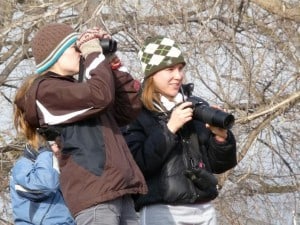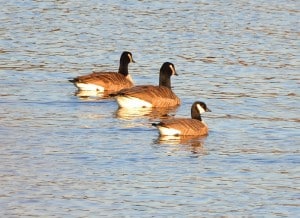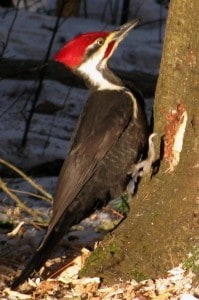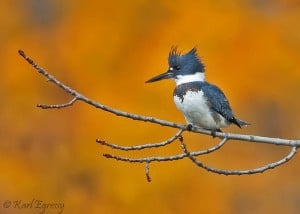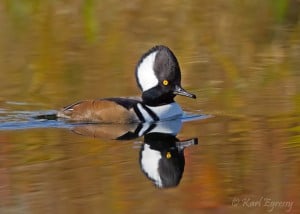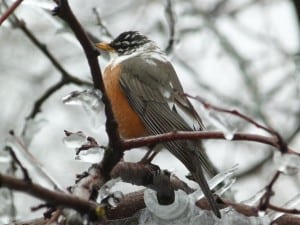Between mid-December and early January, birders from across North, Central and South America take a break from holiday season excess to spend a day in the fresh air, identifying and counting birds. Dating all the way back to 1900, Christmas bird counts represent the biggest organized birding event in the world and a holiday tradition for over 50,000 birders each year. The counts first began from a desire to count birds rather than shoot them. In doing so, they gave birth to North America’s modern conservation movement.
There are two counts in the Peterborough area. One is centred in the city itself and the other in Petroglyphs Provincial Park on the north shore of Stony Lake. Both counts cover a circle 24 kilometres in diameter, take one day each to complete and are organized by a count compiler. Martin Parker organizes the Peterborough count, while Colin Jones is in charge of the Petroglyphs count. Working in small groups and covering the circle by car and by foot, birders work from dawn to dusk identifying and counting every bird they see or hear. The count is open to anyone who wishes to participate. If you are a beginning birder, you will be able to join a group that includes at least one experienced birdwatcher.
Peterborough Count
The 64th Peterborough Christmas Bird Count was held December 20th under sunny, mild conditions. Forty-five members and friends of the Peterborough Field Naturalists spent all or part of the day in the field, while four others kept track of birds visiting their feeders. The first party was out at 4:30 a.m. listening and calling for owls.
By the end of the day, participants found 16,558 individual birds, which is a new high. A total of 58 species were recorded, four more than the 10-year average. Because mild fall weather continued throughout December and all of the lakes and rivers in the area were open, a large number of waterbirds were still present, including a new species for the Count, the Cackling Goose. It brings the total number of species found on the Count since its beginning to 128. The first Peterborough CBC took place in 1953.
As for numbers of birds, record highs were tallied for Canada Goose (3795), Northern Shoveler (4), Redhead (2), Bufflehead (13), Hooded Merganser (15), Ring-billed Gull (399), Eastern Screech-owl (4), Belted Kingfisher (4), Pileated Woodpecker (17), American Crow (813), Black-capped Chickadee (2044), White-breasted Nuthatch (138), and Purple Finch (60). Some other notable birds included an Iceland Gull, 5 Red-bellied Woodpeckers, 3 Merlins, 202 American Robins, a Hermit Thrush, a Red-winged Blackbird, and 128 Pine Siskins. As is the case every year, there were also some notable low numbers. For instance, observers only found one Northern Shrike and three Great Horned Owls. The latter is declining throughout its range.
The overall data for the Peterborough count is as follows: Cackling Goose 2, Canada Goose 3795, American Black Duck 3, Mallard 1141, Northern Shoveler 4, Redhead 2, Great Scaup 1, Bufflehead 13, Common Goldeneye 45, Hooded Merganser 15, Common Merganser 54, Ruffed Grouse 8, Wild Turkey 164, Northern Harrier 4, Sharp-shinned Hawk 1, Cooper’s Hawk 3, Bald Eagle 2, Red-tailed Hawk 45, Ring-billed Gull 399, Herring Gull 440, Iceland Gull 1, Great Black-backed Gull 1, Rock Pigeon 1861, Mourning Dove 337, Eastern Screech-Owl 4, Great Horned Owl 3, Barred Owl 1, Belted Kingfisher 4, Red-bellied Woodpecker 5, Downy Woodpecker 86, Hairy Woodpecker 51, Pileated Woodpecker 17, Merlin 3, Northern Shrike 1, Blue Jay 191, American Crow 813, Common Raven 19, Black-capped Chickadee 2044, Red-breasted Nuthatch 13, White-breasted Nuthatch 138, Brown Creeper 6, Golden-crowned Kinglet 6, Hermit Thrush 1, American Robin 202, European Starling 1995, Cedar Waxwing 270, Snow Bunting 308, American Tree Sparrow 253, Dark-eyed Junco 436, White-throated Sparrow 1, Song Sparrow 1, Northern Cardinal 112, Red-winged Blackbird 1, House Finch 80, Purple Finch 60, Common Redpoll 2, Pine Siskin 128, American Goldfinch 887, and House Sparrow 112.
Petroglyph Count
The 30th Petroglyph Christmas Bird Count took place on December 30th. The 22 participants enjoyed clement weather, ice-free lakes and good listening conditions. Much of birding is done by ear, so calm days are best. A total of 40 species were found, which tied the previous high. The number of individual birds (2666) was slightly above average, too. One new species for the count was recorded, which surprisingly enough was the Mallard. Birders found 26 of these ducks on Stony Lake and one on Jack Lake. Thanks to the open water, a variety of waterfowl that have usually left the area by December also turned up. They included a record number of American Black Ducks (10), Common Goldeneye (28), Hooded Merganser (30), and Common Merganser (500, which shattered the previous record of 97). A record high 30 Pileated Woodpeckers were also found. Some other birds of note were 2 Common Loon, 2 Winter Wren (one of which was actually singing!), 51 Red Crossbill, and 8 Bald Eagle. Some common species that occurred in good numbers were Ruffed Grouse (31), Red-breasted Nuthatch (244), Brown Creeper (32) and Golden-crowned Kinglet (49). Finch diversity, too, was excellent with six species recorded. As for low counts, only 5 Mourning Doves, 1 Barred Owl and 151 Blue Jays were tallied. The latter species usually numbers well over 300, but a below-average acorn crop probably explains their relative scarcity. Many jays have simply chosen to migrate south this year in search of more abundant food.
A worrisome miss for the count was the Gray Jay. Prior to 2010, the average count for Gray Jays was five, and they were recorded every year with the exception of 1990. Gray Jays are one of many species that are expected to decrease in number as the climate warms, especially at the southern edge of their range such as here in the Kawarthas. It is also interesting that only one Barred Owl made an appearance, since good numbers of this species have been seen in the area in recent weeks.
The overall data for the Petroglyph count is as follows: Canada Goose 3, American Black Duck 10, Mallard 27, Bufflehead 1, Common Goldeneye 28, Hooded Merganser 30, Common Merganser 500, Ruffed Grouse 31, Wild Turkey 40, Common Loon 2, Bald Eagle 8, Northern Goshawk 1, Red-tailed Hawk 2, Herring Gull 4, Rock Pigeon 32, Mourning Dove 5, Barred Owl 1, Downy Woodpecker 32, Hairy Woodpecker 37, Pileated Woodpecker 30, Northern Shrike 1, Blue Jay 151, American Crow 11, Common Raven 95, Black-capped Chickadee 660, Red-breasted Nuthatch 244, White-breasted Nuthatch 132, Brown Creeper 32, Winter Wren 2, Golden-crowned Kinglet 49, European Starling 18, American Tree Sparrow 33, Dark-eyed Junco 65, Snow Bunting 5, Purple Finch 10, Red Crossbill 51, Common Redpoll 18, Pine Siskin 167, American Goldfinch 91, and Evening Grosbeak 1. A Golden Eagle and a Ring-billed Gull were also seen during the count period but not on the day of the count.
Junior Count
In order to help young people develop an interest in birding, the second annual Junior Christmas Bird Count also took place this year. Organized by the Peterborough Field Naturalists, 16 young naturalists spent part of the morning of January 3 scouring the grounds and nearby trails of the Camp Kawartha Environment Centre on Pioneer Road. The junior event incorporates many of the features as the adult version. However, it is far less rigorous and designed more like a game. The objective is to contribute to citizen science while having fun. This year, the children found 12 species with the help of leaders Dave Milsom, Sean Smith and Martin Parker. The highlight of the morning was 35 American Robins.
Great Backyard Bird Count is coming!
If you are interested in contributing to citizen science and maybe introducing your children or grandchildren to birding, consider taking part in the Great Backyard Bird Count (GBBC). It takes place February 12-15. The GBBC engages bird watchers of all levels of expertise to create a real-time snapshot of the whereabouts and relative abundance of birds in mid-winter. Anyone can participate. Simply tally the numbers and kinds of birds you see for at least 15 minutes on one or more days of the count. You can count from any location, anywhere in the world! Click here for details.
